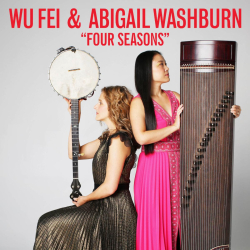New Banjo-Guzheng Mashup, “Four Seasons,” out today
Wu Fei & Abigail Washburn out April 3rd on Smithsonian Folkways

Today Wu Fei & Abigail Washburn shared “Four Seasons,” the latest single from the upcoming self-titled album by the guzheng master and GRAMMY-winning banjoist, out April 3rd on Smithsonian Folkways. The rollicking, elegant love song comes from a tradition of Northwestern Chinese folk songs that cite the four seasons as metaphors for love and friendship - here, daffodil, pomegranate, orange, osmanthus, and snow represent a girl’s longing for love - and this version traces its popularity to a 1956 stage show called “Hua’er and Youth.”
Listen to “Four Seasons” HERE, and read more at Folk Alley HERE, which called the song "a new, exquisite recording" that lands "on a unison note so powerful and precise, it’s hard to believe it’s two separate voices."
Pre-order the album HERE
Wu Fei and Abigail Washburn is a musical celebration of Chinese-Appalachian cross-cultural embrace. Melding guzheng and banjo melodies to traditional lyrics from Chinese and American Southern old-time songs alike, the project, produced by Béla Fleck, is at once an unpacking of the often muddled and misattributed roots of folk traditions, and a tribute to the common, human roots that span continents and time.
Abigail Washburn said of the song, "When I sing and play clawhammer banjo with Fei on this Chinese folk song from Qinghai, I like to imagine the bold women of the Tibetan plateau on horseback calling out to their lovers. Badass ladies of the high plains!”
And Wu Fei said, "Four Seasons is a love song from Qinghai 青海 (dark ocean) Province in northwest China. Folks songs are known as Huar 花儿 (flowers that imply to young women) and Shaonian 少年 (young men) from that region. Four Seasons uses the flowers that blossom from each season to express romance that young people have for each other, especially from the girls to the boys!"
Wu Fei & Abigail Washburn On the Web:
http://www.abigailwashburn.com/
About Smithsonian Folkways:
Smithsonian Folkways Recordings, the "National Museum of Sound," makes available close to 60,000 tracks in physical and digital format as the nonprofit record label of the Smithsonian, with a reach of 80 million people per year. A division of the Smithsonian Center for Folklife and Cultural Heritage, the non-profit label is dedicated to supporting cultural diversity and increased understanding among people through the documentation, preservation, production and dissemination of sound. Its mission is the legacy of Moses Asch, who founded Folkways Records in 1948 to document "people's music" from around the world. For more information about Smithsonian Folkways Recordings, visit folkways.si.edu.
